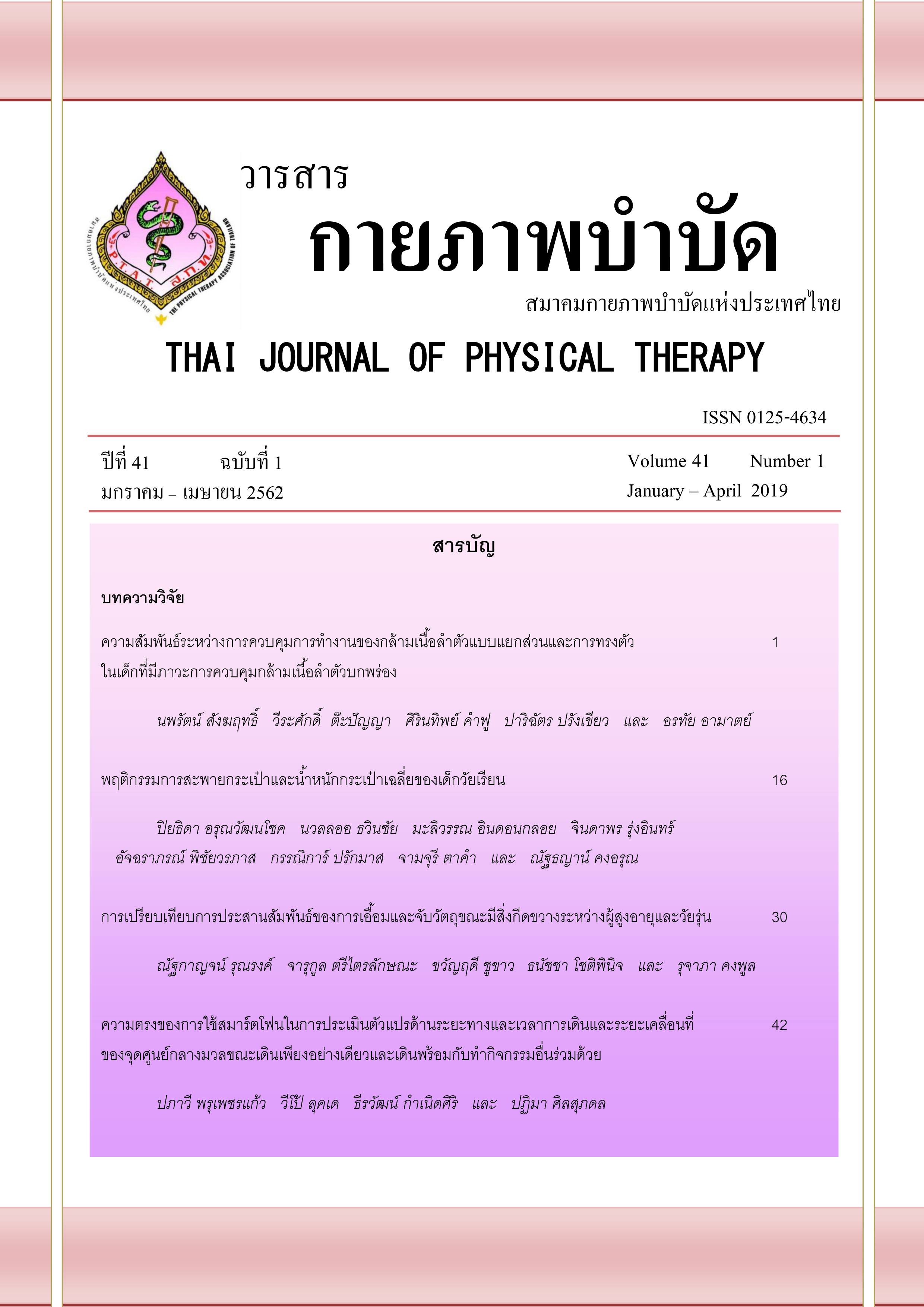พฤติกรรมการสะพายกระเป๋าและน้ำหนักกระเป๋าเฉลี่ยของเด็กวัยเรียน
Main Article Content
บทคัดย่อ
บทนำ พฤติกรรมการใช้กระเป๋านักเรียนที่ไม่เหมาะสม รวมถึงน้ำหนักของกระเป๋าที่มากเกินไป เป็นปัจจัยที่ทำให้เกิดการเปลี่ยนแปลงท่าทางของร่างกาย ส่งผลให้เกิดอาการปวดต่อระบบกระดูกและกล้ามเนื้อในเด็กวัยเรียนได้ วัตถุประสงค์ เพื่อสำรวจพฤติกรรมการใช้กระเป๋าและน้ำหนักกระเป๋าเฉลี่ยของนักเรียนชั้นมัธยมศึกษาตอนต้น
วิธีการ เก็บข้อมูลนักเรียนชั้นมัธยมศึกษาปีที่ 1-3 โรงเรียนจ่านกร้อง อำเภอเมือง จังหวัดพิษณุโลก จำนวน 309 คน โดยใช้แบบสอบถามเกี่ยวกับการใช้กระเป๋าและอาการปวดจากการสะพายกระเป๋านักเรียน วิเคราะห์ข้อมูลโดยใช้สถิติเชิงพรรณนา โดยรายงานออกมาเป็นค่าร้อยละของน้ำหนักกระเป๋าเมื่อเทียบกับน้ำหนักตัว
ผลการศึกษา นักเรียนส่วนใหญ่ใช้กระเป๋าสะพายหลังสองสายแบบไม่มีสายรัดอกและเอว (ร้อยละ 77) สะพายกระเป๋าที่ระดับต่ำกว่าเอว (ร้อยละ 45.6) ใช้เวลาสะพายน้อยกว่า 10 นาทีต่อวัน (ร้อยละ 32.4) โดยสะพายกระเป๋าระหว่างเดินทางไปกลับบ้านและโรงเรียน (ร้อยละ 35.6) ส่วนมากมีอาการปวดบริเวณไหล่ทั้งสองข้าง (ร้อยละ 62) และค่าร้อยละของน้ำหนักกระเป๋าเมื่อเทียบกับน้ำหนักตัวเฉลี่ยอยู่ที่ 6.22±3.04
สรุปการศึกษา นักเรียนส่วนใหญ่ใช้กระเป๋าที่มีค่าร้อยละของน้ำหนักกระเป๋าเมื่อเทียบกับน้ำหนักตัวไม่เกิน 10 ตามคำแนะนำโดยทั่วไป แต่ยังมีพฤติกรรมการใช้กระเป๋าไม่เหมาะสม และวิธีการสะพายกระเป๋าที่ไม่ถูกต้อง ดังนั้น การให้ความรู้และคำแนะนำ ให้นักเรียนตระหนักถึงการสะพายกระเป๋าที่เหมาะสมจึงเป็นสิ่งสำคัญ เพื่อลดปัจจัยเสี่ยงที่จะทำให้เกิดผลเสียต่อสุขภาพของเด็กต่อไป
Article Details
เอกสารอ้างอิง
2. Kovacs FM, Gestoso M, Gil del Real MT, Lopez J, Mufraggi N, Mendez JI. Risk factors for non-specific low back pain in schoolchildren and their parents: a population based study. Pain.2003;103(3):259-68.
3. Rodríguez-Oviedo P, Ruano-Ravina A, Pérez-Ríos M, García FB, Gómez-Fernández D, Fernández-Alonso A, et al. School children’s backpacks, back pain and back pathologies. Arch Dis Child.2012;97(8):730-2.
4. Negrini S, Carabalona R. Backpacks on! Schoolchildren's perceptions of load, associations with back pain and factors determining the load. Spine. 2002;27:187-95.
5. Navuluri S, Carabalona R. Study on the relationship between backpack use and back and neck pain among adolescents. Nurs Health Sci. 2006;8:208-15.
6. Sheir-Neiss GI, Kruse RW, Rahman T, Jacobson LP, Pelli JA. The association of backpack use and back pain in adolescents. Spine.2003;28:922-30.
7. Rai A, Agarawal S. Back problem due to heavy backpack in school children. J Human Social Sci.2013;10(6):22-6.
8. Mackie H, Stevenson J, Reid S, Reid SA, Legg SJ.The effect of simulated school load carriage on shoulder strap tension forces and shoulder interface pressure. Appl Ergonomics.2005;36:199-206.
9. Whittfield J, Legg SJ, Hedderley DI. Schoolbag weight and musculoskeletal symtomps in New Zealand secondary schools.Appl Ergonomics.2005;36:193-8.
10. Haselgrove C, Straker L, Smith A, O'Sullivan P, Perry M, Sloan N. Perceived school bag load, duration of carriage and method of transport to school are associated with spinal pain in adolescents. Aust J Physiother.2008;54(3):193-200.
11. Hong Y, Fong DT, Li JX. The effect of school bag design and load on spinal posture during stair use by chidren. Ergonomics.2011;54:1207-13.
12. Abdullah AM, McDonald R, Jaberzadeh S. The effects of backpack load and placement on postural deviation in healthy students: a systematic review. Int J Eng Res Appl.2012 Nov-Dec;2(6):466-81.
13. Negrini S, Negrini A. Postural effects of symmetrical and asymmetrical loads on the spines of schoolchildren. Scoliosis.2007;2:8.
14. Chansirinukor W, Wilson D, Grimmer K, Dansie B. Effect of backpacks on students : measurement of cervical and shoulder posture. Aust J Physiother.2001;47(2):110-6.
15. Golriz S,Walker b.Can load carriage system weight, design and placement affect pain and discomfort? A systematic review. J Back Musculoskelet Rehabil.2011;24:1-16.
16. Mackie HW, Beadle LJ, Hedderley D. Comparison of four different backpacks intended for school use.Appl Ergon.2003;34(3):257-64.
17. Al-Hazzaa HM. School backpack. How much load do Saudi school boys carry on their shoulders? Saudi Med J.2006;27(10):1567-71.
18. Forjuoh SN. School backpack weight: a survey of students in Ghana, Guatemala and the USA. In Control Saf Promot.2004;11(4):287-9.
19. Deesungnern S, Thawinchai N. A survey of factors associated with schoolbag carrying and pain during schoolbag usage in high school students of Darawittayalai School, Chiang Mai.Thai J of Phys Ther.2014;36(2):70-8.
20. Ruttanaseeha W, Sahunin A, Supad P, et al. Study of weiht excess of year 1-4 students' school bag at Khon Kaen University Primary Demonstration School. Srinagarind Med J.2009;24(1):1-8.
21. Bernstein RM, Cozen H. Evaluation of back pain in children and adolescents. Am Fam Physician.2007;76:1669-76.
22. David J. Evaluation of back pain in children. Paediatr Child Health.2003;18:56-60.
23. Silpjaru T. SPSS for research and statistics. 9th ed. Bangkok: Business R&D; 2008.
24. Tirakanon S. Methodology on social science research: Guides to implementation. 2nd ed. Bangkok : Chulalongkorn University Printing House; 2008.
25. Lindstrom-Hazel D. The backpack problem is evident but the solution is less obvious. Work.2009;32:329-38.
26. The American Occupational Therapy Association. Backpack Facts: What’s all the flap about? [cited 2014,March 10. Available from: https://www.aota.org/media/CorporateFiles/Backpack/Whats%20All%20the%20Flap%20About.pdf
27. Singh T, Koh M. Effects of backpack load position on spatiotemporal parameters and trunk forward lean. Gait and Posture. 29,2009,49-53.
28. Chow DH, Leung KT, Holmes AD. Changes in spinal curvature and proprioception of schoolboys carrying different weights of backpack. Ergonomics.2007;50(12):2148-56.
29. Hundekari J, Chilwant Kalyan, Vedpathak S, Wadde S. Does alteration in backpack load affects posture of school children? J Den Med Sci.2013;7(4):71-5.
30. Ramprasad M, Allas J, Raghuveer AK. Effect of backpack weight on postural angles in preadolescent children. Indian Pediatrics.2010;47(7):575-8.
31. Kisner F, Fiebert I, Roach K, Moore J.Postural compensations and subjective complaints due to backpack loads and wear time in schoolchildren.Pediatr Phys Ther.2013:25:15-24.
32. Korvessis P, Koureas G, Zacharatos S, Papazisis Z. Backpacks, back pain, sagital spinal curves and trunk alignment in school adolescent. Spine.2005:30(2);247-55.
33. Smith B, Ashton KM, Bohl D, Clark D, clark RC, Metheny JB, Klassen S. Influence of carrying a backpack on pelvic tilt, rotation, and obliquity in female college students.Gait Posture.2006;23(3):263-7.
34. Drzal-Grabiec J, Snela S, Rachwal M, Podgorska J, Rykala J. Effect of carrying a backpack in an asymmetrical manner on the asymmetries of the trunk and parameters defining lateral flexion of the spine. Hum Factors.2015;57(2):218-26.
35. Sedrez JA, de Rosa MI, Noll M, Medeiros Fda S, Candotti CT. Risk factors associated with structural postural changes in the spinal column of children and adolescents. Rev Paul Pediatr.2015.33(1):72-81.
36. Phonpichit C, Chansirinukor W, Akamanon C. The response of the body when carrying a handbag. Work.2016 Nov22;55(3):673-8.
37. Abutaleb DDM.Effect of shoulder side pack on dynamic postural stability in young healthy female.Int J Physiother.2016;3(3):252-7.
38. Qureshi Y, Shamus E. Unilateral shoulder bags: can they be won in a way to reduce postural asymmetry?. The International Journal of Allied Health Science and Practice.2012;10(4):1-9.
39. Dianat I, Karimi MA. Association of parental awareness of using schoolbag with musculoskeletal syndroms and carrying habits of schoolchildren. J Sch Nurs.2013;0(0):1-8.
40. Dianat I, Javadivala Z, Asghri-Jafarabadi M, Asl Hashemi A, Haslegrave CM. The use of schoolbag and musculoskeletal symptoms among primary school children: are the recommended weight limits adequate?Ergonomics.2013;56:79-89.


